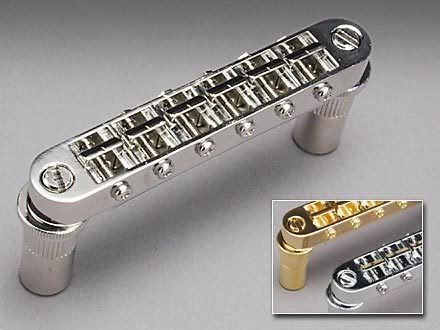For some time now my SG Special Faded (2002-ish w/ the half moon inlays, too cool for words) has been in some sorry shape. It just sounded dull. Imagine you have the deadest strings you've ever had in your life only worse. Even brand new strings would sound bright but there'd be this weird undercurrent of mud. I couldn't figure it out. I swapped in two different sets of pickups and dropped in a replacement bridge and it sounded different, maybe better, but there was still a general problem w/ the overall sound. Eventually, I narrowed it down to the bridge posts. This had been my one workhorse guitar for many, many years and over time my sweat had actually weakened the wood around the original posts. As you can see here, especially on the bottom, it is pretty gross:

(Also, you can see the GFS Crusader pickup I have in the bridge there. Great sounding pickup. Judging by the appearance it is meant to be a Duncan Invader clone and I guess it is pretty close in terms of output but maybe it's not quite a snarly and a little warmer sounding.)
Now since the wood surrounding the posts was the problem, I was either going to have to drill them out and dowel them or find a bridge w/ larger posts. I opted for the later. The bridge I used is a Gotoh tune-o-matic:

As you can see, they mount on big bushings almost like a wraparound bridge. Some people don't like Gotoh hardware but I think they're nuts. I have some Gotoh mini tuners on my baritone and I think they're as good as anything. I think they get a bad name because they're more of a budget brand but, honestly, they're made in Japan and I doubt many humans on this planet could tell the difference between their stuff and, say, Schaller in a practical setting (not to say that the Schaller aren't made better--I don't know one way or the other).
The installation of this is simple (though it took a good deal of web searching for me to be satisfied that I knew what I was doing). You just drill holes and tap 'em in w/ a mallet. It's that simple. I wanted to use an 11 mm bit but my local orange warehouse of overpriced tools didn't have metric bits. I settled for 7/16 inch. Since my drill press isn't large enough to drill tune-o-matic posts, I made a little guide out of some scrap MDF. To judge my depth I used a piece of masking tape, which always works like a charm.
As you can see, there' s not much marine of error between he depth I needed for the bushings and the thin SG body:

I very carefully drilled through a piece of masking tape. (The tape keeps the finish from chipping--not a big deal on this guitar.) It worked well enough:

I pressed in the bushings w/ my fingers and then gave 'em a few good whacks w/ a rubber mallet for good measure. I'm not sure if this is the right way to go about things but it feel sturdy to me. The holes in the pick guard weren't big enough for the bushings so I routed it out to fit them. Kinda got a little wild w/ it so it's not pretty:

Fortunately, this is mostly covered by the bridge posts once it's fully installed. It also so happens that the tops of the bushings are just about flush w/ the pickguard.
W/ that taken care of, I decided I might as well change out the tuners while I was at it. I had some Planet Waves auto-trimmers on there for a couple years and while I like 'em OK, I could never really get used to them. Also, I lost a piece of one of them so I had to put on of the original Gibson tuners on there, which looked kinda cool in a used and abused kinda way:

I liked the look of the stock Gibsons but I thought I might try something else just because so I got some Grover keystone style ones that looked the same but hopefully are a bit higher quality. These are a cinch to swap out. Unscrew the nut on top w/ a wrench and and take out the screws on the back. Do the reverse to get the new ones on. Voila!

And there she is, the SGeezus. I need to give it a couple days to be sure but as of now it's looking like the new bridge fixed her right up. Since I detune two and a half steps down, the intonation is a little off (always the case w/ tune-o-matic bridges) but the sound is much, much clearer now.





















































